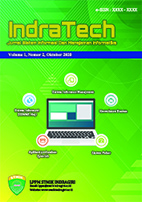OPTIMALISASI PENETAPAN KEPANGKATAN GURU MENGGUNAKAN FUZZY MAMDANI
Abstract
The abstract is to be in fully-justified italicized text, at the top of the paper with single column as it is here, below the author information. Use the word “Abstract” as the title, in 10-point Times, boldface type, left relative to the column, initially capitalized. The abstract is to be in 10-point, single-spaced type, and up to 200 words in length. Leave two blank lines after the abstract or list three to five keywords related to the articles, then continued with abstract in bahasa Indonesia.
Keywords: abstract keywords
AbstrakBadan Kepegawaian Daerah (BKD) Indragiri Hilir sangat mengapresiasi pengembangan diri guru Pegawai Negeri Sipil (PNS). Pengembangan diri dilakukan dengan cara menaikan kepangkatan. Saat ini, sistem yang digunakan masih secara konvensional, sehingga tidak optimal dalam penentuan pangkat. Penelitian ini bertujuan membangun suatu sistem yang dapat menoptimalisasi proses kenaikan pangkat. Metode yang digunakan adalah Fuzzy Mandani terhadap seluruh data guru Sekolah Dasar (SD) PNS pada BKD Indragiri Hilir. Hasil penelitian ini berupa nilai kelayakan kenaikan pangkat guru PNS. Sehingga penilitian ini dapat digunakan sebagai rujukan dalam optimalisasi kepangkan guru PNS.
Keywords: Artificial Intelegent, Mamdani, Guru, Optimalisasi, Kepangkatan
Full Text:
PDFReferences
Menteri Pendidikan Nasional, “Peraturan Menteri Pendidikan Nasional nomor 38 Tahun 2010,” vol. 2008, pp. 1–15, 2010.
N. A. Prabowo and N. Hidayah, “Sistem Penetapan Angka Kredit untuk Kenaikan Pangkat Guru di Lingkungan Pemerintah Kota Magelang Berbasis Web,” Sci. J. Informatics, vol. 2, no. 2, p. 155, 2017.
R. Monalisa and K. Kusnawi, “Decision support system of model teacher selection using PROMETHEE method,” Proc. - 2017 Int. Conf. Innov. Creat. Inf. Technol. Comput. Intell. IoT, ICITech 2017, vol. 2018-Janua, pp. 1–8, 2018.
V. S. R. Poli, “Fuzzy Certainty Factor for incomplete information,” 2016 Int. Conf. Fuzzy Theory Its Appl. iFuzzy 2016, no. X, 2017.
A. H. Abdullah, “Technology , Engineering and Mathematics ( STEM ) Education from the Cognitive , Affective and Behavioural Aspects,” IEEE Int. Conf. Teaching, Assessment, Learn. Eng. Page, no. December, pp. 6–12, 2017.
A. D. Riyanto, H. Marcos, Z. Karini, and K. M. Amin, “Fuzzy logic implementation to optimize multiple inventories on micro small medium enterprises using mamdani method (Case Study: Pekanita, Kroya, Cilacap),” Proc. - 2017 2nd Int. Conf. Inf. Technol. Inf. Syst. Electr. Eng. ICITISEE 2017, vol. 2018-Janua, pp. 261–266, 2018.
T. T. Zizi et al., “Lecturer Promotion Assessment System based on Fuzzy Logic,” ICICTM 2016 - Proc. 1st Int. Conf. Inf. Commun. Technol., no. May, pp. 19–22, 2017.
P. A. F. Islami, K. M. Moses, M. N. Lestari, and A. P. Wibawa, “Simulasi penentuan guru berprestasi dengan metode fuzzy logic mamdani inference menggunakan aplikasi matlab,” vol. 02, pp. 8–14, 2017.
F. A. Minarni, “Prediksi Jumlah Produksi Roti Menggunakan Metode Logika Fuzzy,” Teknoif, vol. 4, no. 2, pp. 59–65, 2016.
DOI: https://doi.org/10.56005/jit.v1i2.35
Refbacks
- There are currently no refbacks.







